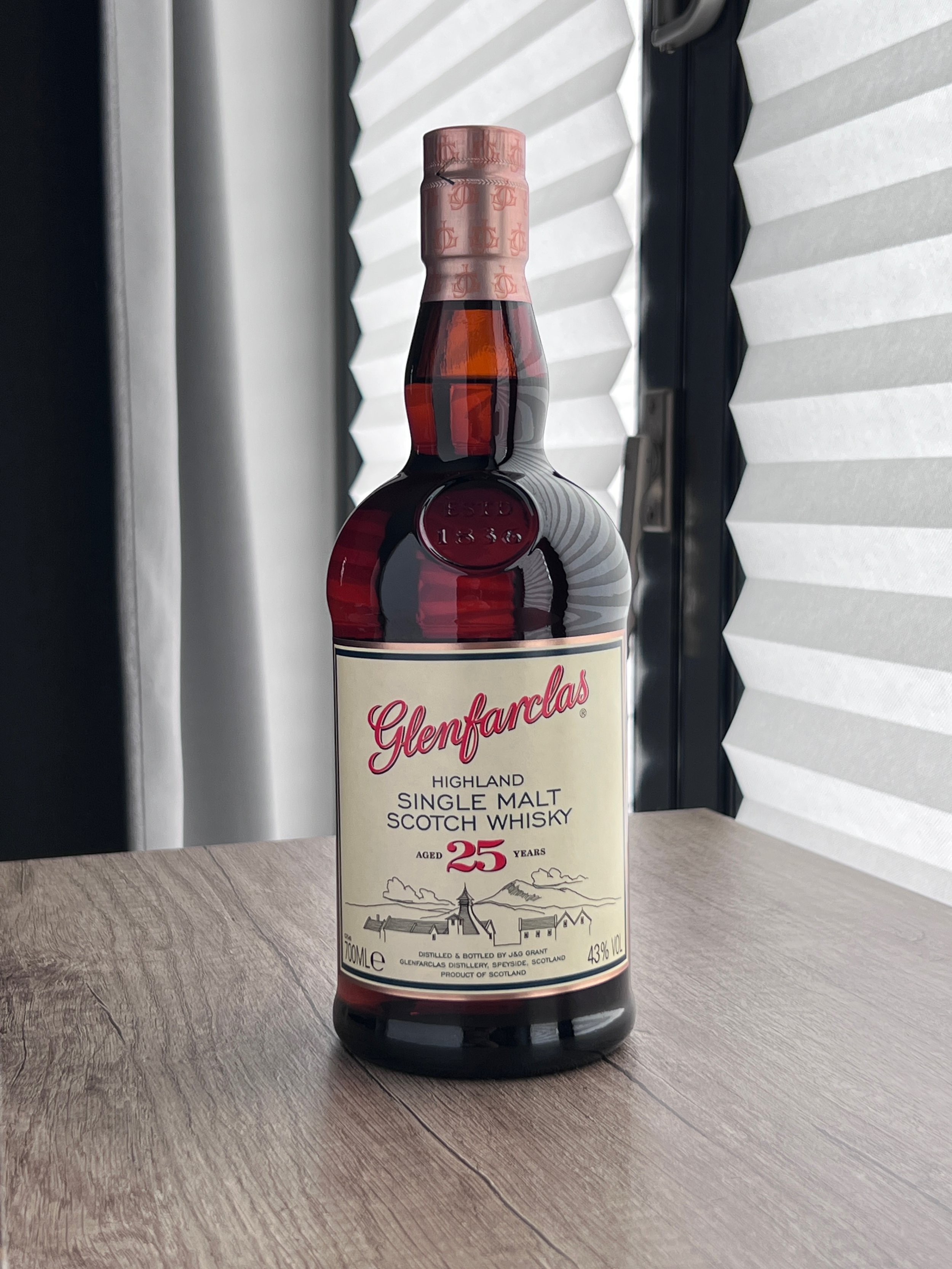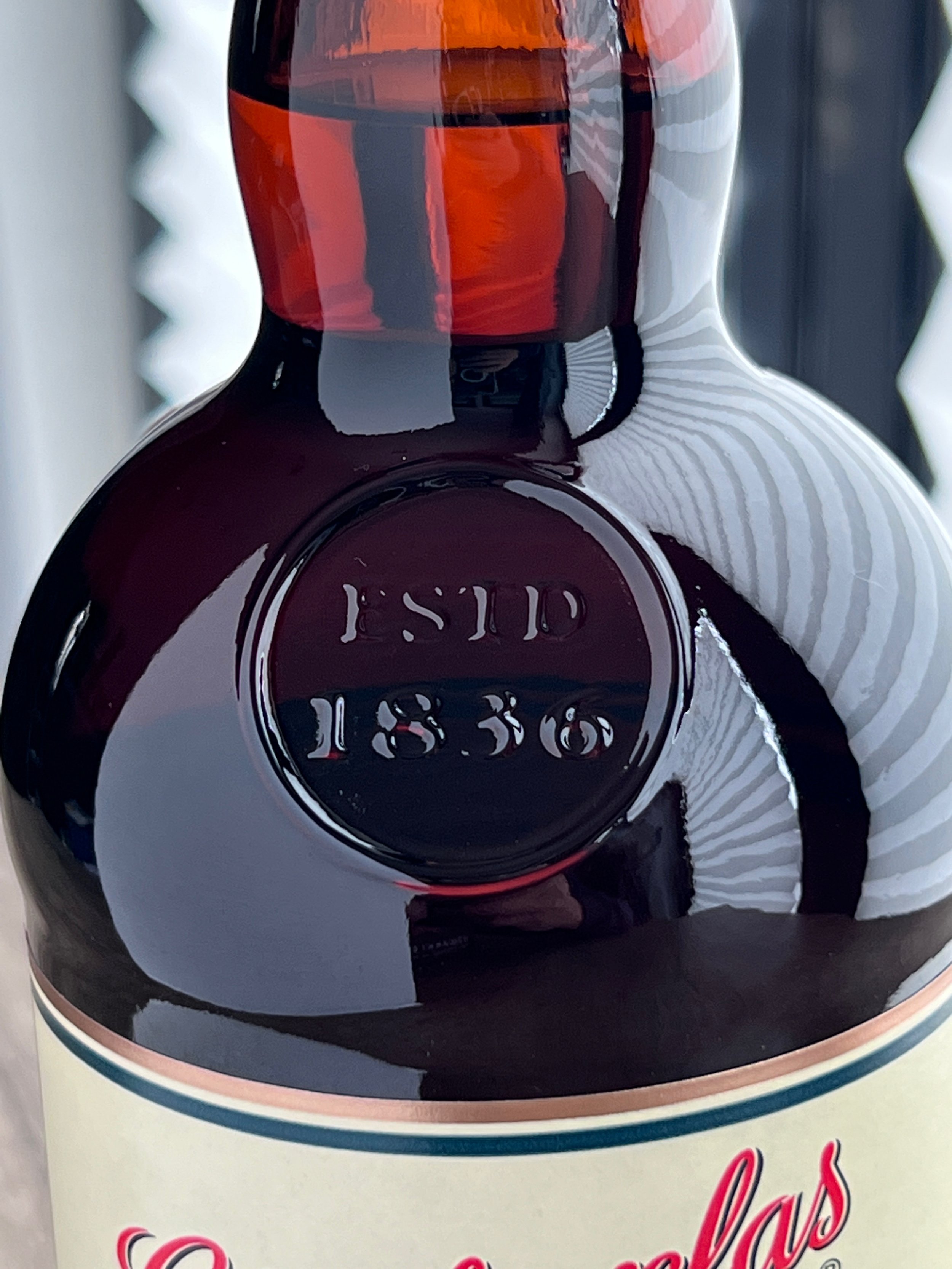Glenfarclas 25yo
Official Bottling | 43% ABV
Score: 6/10
Good stuff.
TL;DR
…but could be so much more
The only official 25yo whisky I can afford
When I visited Glenfarclas Distillery back in 2019, it was for me – and it still is today – the quintessential Speyside distillery, even if they bill themselves as a “Highland” malt.
While other distilleries just down the road in Dufftown sell much more and are much more widely known, Glenfarclas for me has always had more substance and interest, and not just because of the little extra ABV we get with several of their expressions of their core range.
I liked and continue to admire that Glenfarclas is one of the last family-owned distilleries in Scotland. I enjoyed the distillery tour, the tasting in the lovely Ship Room, and the friendly tour guide who, despite being the only ones on the tour, didn’t rush my partner and I and even hung out with us for a while after the tour had “officially” ended. It was a nice touch, and one I’ve found that lends me some affection towards the distillery, even if I wouldn’t say that it’s among my very favourites.
The tour understandably weighed heavily towards ensuring us that we knew how many such-and-such Grant family generations devoted their lives to their trade. But, in a whisky landscape largely dominated by far-away multinational corporations, I understood why they make such a point to sell this fairly unique aspect of the distillery. You can of course be a family-owned distillery and make terrible whisky, but I’ve always managed to have good stuff from them.
Batch variation has been a topic of conversation recently with Glenfarclas from very trusted sources and a highly knowledgeable community. I don’t doubt that this is true, but I will say that of the four or five bottles I’ve owned from the distillery, I haven’t had the poor luck to experience a bad one. Just the opposite, actually: every Glenfarclas bottle I’ve spent time with has been good to very good, my pick of the litter being (perhaps unsurprisingly) the 46% 15 year old. Sherried spicy malty dunnage goodness. Glenfarclas for me has simply always been there: not the topic of trendy chatter, nor forgotten whisky that never gets talked about, but always solid.
It was around two years ago now that I heard the news that the-then £120 25 year old was going to jump dramatically in price. The chatter was that Glenfarclas was concerned that their brand was being diluted by having their significantly aged whiskies – notably the 21 and 25 – appear at relatively affordable prices given the rocketing trajectory of seemingly every other whisky over 21 years old. I suppose if you’re a distillery and see your 21 or 25 year old malt on offer at Costco for £90 it might offer the wrong impression to those sweet, sweet premium markets you’re hoping to position your higher-end whiskies into.
I made a quick and easy calculation: when I bought this bottle nearly two years ago now, I looked at this alongside the prices for other 25 year old whiskies. I wasn’t a maths major, but I very quickly concluded that this was a now or never moment for me and a 25 year old whisky. I couldn’t afford two years ago – and still can’t afford – any 25 year old whiskies from my beloved favourite distilleries. I look longingly in the distance towards Campbeltown and Islay, towards Bunnahabhain 25, Glen Scotia 25, and Springbank 25, knowing that I’ll likely never have a bottle, but perhaps a dram in a pub, on a very special occasion.
I took a punt and bought the bottle, because I knew that while £120 was a lot of money for 43% whisky even at 25 years, I definitely was not going to pay the new price. I recently finally opened the bottle and have been nursing it for a couple of months now, hoping it would open up before I reviewed it.
Review
Glenfarclas 25yo, Official release, 43% ABV
£120 paid, now £225 or more. Wide availability.
Score: 6/10
Good stuff.
TL;DR
…but could be so much more
Nose
Honey, malty, mellowed zesty fruits, an old sherry-soaked oakiness, vanilla pod. It’s light, but you can tell on the nose that there is age here. Faint dunnage notes, too.
Palate
Sherry spice, stewed fruits, light tobacco and even lighter faint chocolate notes. Sherried oak again, with the sherry notes much more attached to the oakiness than on the nose. Mellow maltiness. Sherried vanilla, if that’s a thing. Even to my inexperienced palate when it comes to old whiskies, the age is here on the palate as well, even if it’s been toned down by the lower ABV. To my palate, the age comes through in the way that the sherry influence, oak, and maltiness are much more integrated, married, and marinated together after a quarter century in the casks. This sherry-oak-maltiness forms the deepest layer here yet also appears alongside the other notes.
The Dregs
You know what my gripe is going to be.
On one hand, I have some affection towards the distillery, and I find myself wanting to like this a lot. On the other hand, my wallet is telling me there’s no way in whisky heaven or hell that I’d pay the current retail price for this.
In this sense I can only agree with Broddy in his review earlier this year of the Glenfarclas 21. This is good, no doubt about it. The integration is something that I quite clearly don’t come across in the same way in younger whiskies. But there’s no way around it: the 43% pulls everything down.
I’ve never tasted 46% or cask strength 25 year old Glenfarclas, so technically I can’t propose the counterfactual. But, knowing well and being a fan of Glenfarclas 105, I do know what a more naturally presented Glenfarclas is capable of (even if batch variation is perhaps a bigger issue with the 105 than with other expressions, in my experience). I can’t help but wonder what a 46%, unchillfiltered version of this would be like.
But c’est la vie, this is what we have, and I’m glad to grabbed it at the old retail price. It’s good, easy drinking, interesting and one to sit with for a while and pick apart what’s here. I won’t be purchasing it again, at least at the current price, but I’m glad to have this bottle to get to know, even if I’m predictably left wondering what could have been.
Score: 6/10
Tried this? Share your thoughts in the comments below. DD
-
Dramface is free.
Its fierce independence and community-focused content is funded by that same community. We don’t do ads, sponsorships or paid-for content. If you like what we do you can support us by becoming a Dramface member for the price of a magazine.
However, if you’ve found a particular article valuable, you also have the option to make a direct donation to the writer, here: buy me a dram - you’d make their day. Thank you.
For more on Dramface and our funding read our about page here.






































